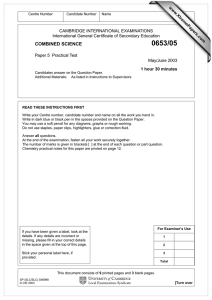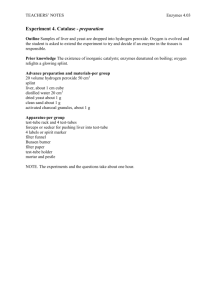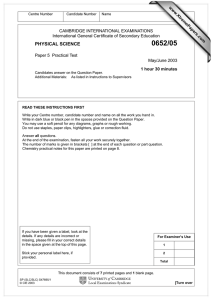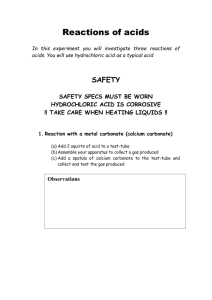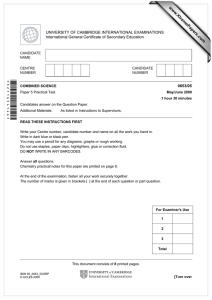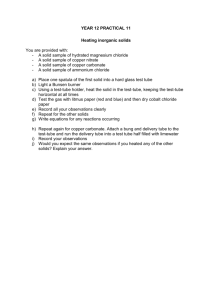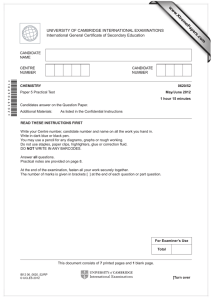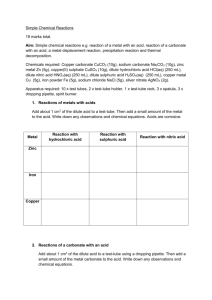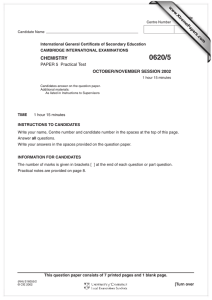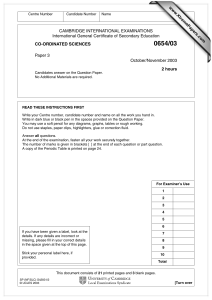0654/05 CO-ORDINATED SCIENCES
advertisement
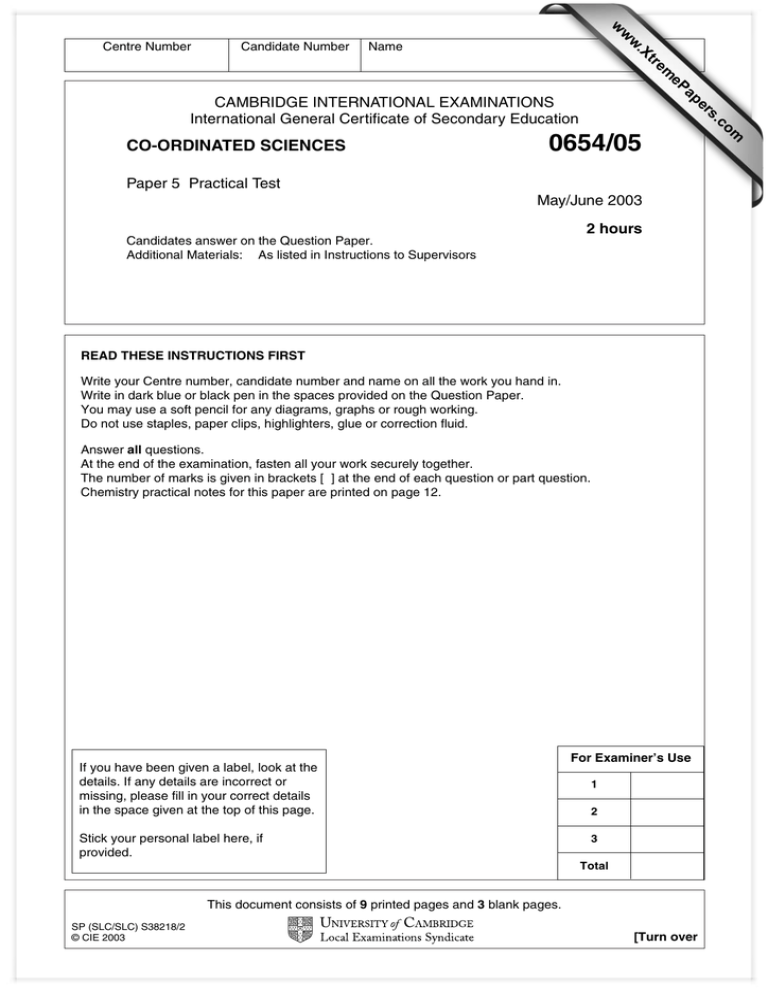
w w Name ap eP m e tr .X Candidate Number w Centre Number 0654/05 Paper 5 Practical Test May/June 2003 2 hours Candidates answer on the Question Paper. Additional Materials: As listed in Instructions to Supervisors READ THESE INSTRUCTIONS FIRST Write your Centre number, candidate number and name on all the work you hand in. Write in dark blue or black pen in the spaces provided on the Question Paper. You may use a soft pencil for any diagrams, graphs or rough working. Do not use staples, paper clips, highlighters, glue or correction fluid. Answer all questions. At the end of the examination, fasten all your work securely together. The number of marks is given in brackets [ ] at the end of each question or part question. Chemistry practical notes for this paper are printed on page 12. If you have been given a label, look at the details. If any details are incorrect or missing, please fill in your correct details in the space given at the top of this page. Stick your personal label here, if provided. For Examiner’s Use 1 2 3 Total This document consists of 9 printed pages and 3 blank pages. SP (SLC/SLC) S38218/2 © CIE 2003 [Turn over om .c CO-ORDINATED SCIENCES s er CAMBRIDGE INTERNATIONAL EXAMINATIONS International General Certificate of Secondary Education 2 1 This question is to show what is produced when food is burned in air. In some ways the process is similar to respiration in the cells of the body. • Set up the apparatus as shown in the diagram, Fig. 1.1(a). clamp test-tube burning toast (a) (b) Fig. 1.1 • • • • • • • Take a small piece of toast and push it onto the tip of a mounted needle. Set fire to the toast by holding it in the flame of a Bunsen burner. When it is burning strongly hold it about two centimetres beneath the test-tube, as shown in Fig. 1.1(b). It must burn for fifteen seconds. If it goes out, light it again and repeat. After fifteen seconds, put the flame out by plunging the needle and burning toast into the beaker of cold water provided. Carefully put a bung in the test-tube, Place the test-tube in a test-tube rack. (a) (i) Feel the outside of the test-tube. What do you notice? ...............................................................................................................................[1] (ii) Look carefully at the inside surface of the test-tube. Describe what you can see. ................................................................................................................................... ...............................................................................................................................[1] (iii) Add about 3 cm depth of limewater to the test-tube. Replace the bung and shake. Record your observation and conclusion. observation ............................................................................................................... conclusion .............................................................................................................[2] (iv) When the toast burned a chemical reaction took place. What reacted with toast? ...............................................................................................................................[1] (v) Describe one way in which respiration in our body cells is different from your burning toast experiment. ................................................................................................................................... ...............................................................................................................................[1] 0654/05/M/J/03 For Examiner’s Use For Examiner’s Use 3 (vi) Describe one way in which respiration is similar to your experiment. ................................................................................................................................... ...............................................................................................................................[1] (b) The toast contained starch. The body cannot make use of the starch until it is broken down to sugar by enzymes in our digestive system. You are provided with two solutions, A and B. One solution contains starch and the other contains protein. Test both solution A and B for protein, using the biuret test. (i) observation with solution A ................................................................................................................................... observation with solution B ...............................................................................................................................[1] (ii) Which solution contains protein? ...................... [1] (c) If the protein solution you have identified is an enzyme it will react with starch, the other solution, to produce a sugar. • • • • (i) Mix together 1 cm depth of each of the solutions A and B in a test-tube. Place the test-tube in a test-tube rack and leave for five minutes. Add an equal volume of Benedict’s solution. Heat the tube in a hot water bath for five minutes. Describe the colour change that took place. ................................................................................................................................... ...............................................................................................................................[1] (ii) Which substance do you definitely know is present in the test-tube now? ...............................................................................................................................[1] (iii) Was the protein solution an enzyme? ...............................................................................................................................[1] (iv) Explain how you know this. ................................................................................................................................... ...............................................................................................................................[1] (d) Another way to find out if there has been a reaction is to see if any starch remains in the test-tube. Describe a test that you could do to find this out. test ................................................................................................................................... result ............................................................................................................................[2] 0654/05/M/J/03 [Turn over 4 2 You are going to investigate the relationship between applied force and extension of a spring. (a) • With a small piece of plasticine, fix the pin P at right angles to the spring, as shown in Fig. 2.1. Hang the spring from the metal rod of a clamp. • Attach the mass carrier to the spring. • Fix the metre rule vertically in the clamp close to the spring with its zero mark at the bottom. P plasticine mass carrier 0 Fig. 2.1 • Make sure that you have left enough space under the spring for it to stretch at least 30 cm when the masses are hung on it. (i) Read off the height, ho, of the pointer on the metre rule. Record ho in millimetres in the table Fig. 2.2. Now add 50 g to the carrier and read off the new height, h, of the pointer. Record h in the table Fig. 2.2. Repeat by adding further 50 g masses until you have added a total of 250 g. (ii) Complete the table, noting that you are required to convert each mass into a force, (1 kg is 10 N) and calculate the total increase in length of the spring each time. total mass added / g force / N 0 0 pointer reading h / mm ho = total increase in length (extension) = ho – h / mm 0 Fig. 2.2 [4] 0654/05/M/J/03 For Examiner’s Use 5 (b) On the graph grid provided, plot a graph of the extension of the spring (vertical axis) against the force. Draw the best straight line through these points. For Examiner’s Use [4] (c) Read off from your graph the extension produced by a force of 3.5 N. extension = ..........................mm 0654/05/M/J/03 [1] [Turn over 6 (d) What is the relationship between the applied force and extension of the spring? .......................................................................................................................................... ......................................................................................................................................[2] (e) A spring is made from thicker wire and the same experiment carried out. Draw a line on your graph for a spring made from this thicker wire. Label the line ‘thicker wire’. [1] (f) Describe how you would find the mass of an object using the experiment already carried out. You need to state the measurements you would make and how the mass would be calculated. .......................................................................................................................................... .......................................................................................................................................... .......................................................................................................................................... .......................................................................................................................................... .......................................................................................................................................... ......................................................................................................................................[3] 0654/05/M/J/03 For Examiner’s Use 7 BLANK PAGE 0654/05/M/J/03 [Turn over 8 3 You are going to investigate the potential difference produced when two different metals are in contact. (a) • Clean the pieces of metal with sandpaper to ensure good electrical contact. • Connect a wire from the negative terminal of the voltmeter to the strip of magnesium, using a crocodile clip. • Place the strip of magnesium under a circle of filter paper. • Add the very dilute acid to the filter paper using a dropping pipette. Add sufficient to make the whole piece of paper wet. • Connect a piece of wire from the positive terminal of the voltmeter to the zinc strip using a crocodile clip. • Press the piece of zinc down onto the wet filter paper above the magnesium strip. See Fig. 3.1. • Read the potential difference and record its value in the table, Fig 3.2. You should also note which metal is acting as the negative pole of the cell produced by the two metals. dropping pipette filter paper strip of metal strip of metal V Fig. 3.1 pairs of metals negative metal potential difference/ V magnesium and zinc copper and magnesium copper and zinc Fig. 3.2 [4] (b) Repeat the procedure with copper and magnesium, then copper and zinc. Use a fresh circle of filter paper each time. 0654/05/M/J/03 For Examiner’s Use 9 (c) From your results, state which of the three metals is the most negative. Explain your answer. .......................................................................................................................................... ......................................................................................................................................[2] (d) Place the metals in order of decreasing reactivity, the most reactive first. ......................................................................................................................................[1] (e) (i) Place a piece of magnesium into about 5 cm3 of copper(II) sulphate solution in a test-tube. Record all your observations. observations ............................................................................................................. ................................................................................................................................... ...............................................................................................................................[3] (ii) Explain these observations. ................................................................................................................................... ................................................................................................................................... ...............................................................................................................................[2] (f) Imagine you are given a metal X together with copper, magnesium and zinc. Describe a method to place the four metals in order of decreasing reactivity, using the apparatus and results of your previous experiment. .......................................................................................................................................... .......................................................................................................................................... .......................................................................................................................................... ......................................................................................................................................[3] 0654/05/M/J/03 For Examiner’s Use 10 BLANK PAGE 0654/05/M/J/03 11 BLANK PAGE 0654/05/M/J/03 12 CHEMISTRY PRACTICAL NOTES Test for anions anion test test result carbonate (CO32–) add dilute acid effervescence, carbon dioxide produced chloride (Cl –) [in solution] acidify with dilute nitric acid, then add aqueous silver nitrate white ppt. nitrate (NO3–) [in solution] add aqueous sodium hydroxide, then aluminium foil; warm carefully ammonia produced sulphate (SO42–) [in solution] acidify, then add aqueous barium chloride or aqueous barium nitrate white ppt. Test for aqueous cations cation effect of aqueous sodium hydroxide + effect of aqueous ammonia ammonium (NH4 ) ammonia produced on warming – copper(II) (Cu 2+) light blue ppt., insoluble in excess light blue ppt., soluble in excess, giving a dark blue solution iron(II) (Fe 2+) green ppt., insoluble in excess green ppt., insoluble in excess iron(III) (Fe3+) red-brown ppt., insoluble in excess red-brown ppt., insoluble in excess zinc (Zn2+) white ppt., soluble in excess, giving a colourless solution white ppt., soluble in excess, giving a colourless solution Test for gases gas test and test result ammonia (NH3) turns damp litmus paper blue carbon dioxide (CO2) turns lime water milky chlorine (Cl 2) bleaches damp litmus paper hydrogen (H2) ‘pops’ with a lighted splint oxygen (O2) relights a glowing splint 0654/05/M/J/03
